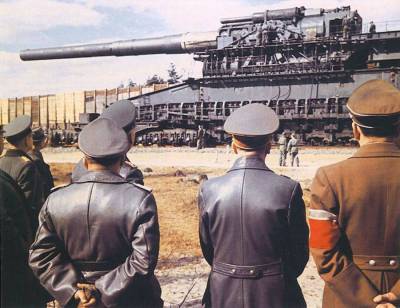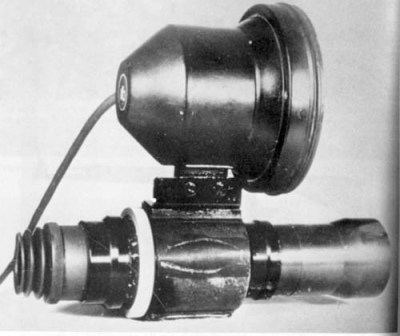

Nazi Weapons Of The Future
source link: https://hackaday.com/2022/09/23/nazi-weapons-of-the-future/
Go to the source link to view the article. You can view the picture content, updated content and better typesetting reading experience. If the link is broken, please click the button below to view the snapshot at that time.
Nazi Weapons Of The Future
We know. The title sounds like a bad newsreel from 1942. Turns out, though, that the Nazis were really good at pouring money into military research and developing — or trying to develop — what they called “wunderwaffe” — wonder weapons. While we think of rockets and jets today as reasonably commonplace, they were state-of-the-art when Germany deployed them during WWII. While the rockets were reasonably successful, the jets were too few and too late to matter. However, those were just the tip of the iceberg. The German war industry had plenty of plans ranging from giant construction to secret weapons that seem to be out of the pages of a pulp science fiction magazine.
Size Matters
Part of the plans included huge ships including one aircraft carrier displacing 56,500 tons. Many of these were never completed and, in some cases, were never actually started. In contrast, the Essex-class USS Hornet displaces 31,300 tons and the Lexington was 37,000 tons. The H-class battleships would have had as much as 140,000 tons of displacement dwarfing the Yamato class (73,000 tons) and the Iowa class (53,000 tons).
Below the water, there were plans for a ballistic missile submarine that never took off. Type XXI U-boats had all-electric propulsion so they could operate completely submerged for long periods. While 118 were being built, only four were completed. There were several other submarines planned with air-independent propulsion.
Gustav railway gun
One of the more interesting designs that didn’t make it to reality was the Type XI — a submarine that could carry a collapsible airplane. There were four being built before the program was canceled. While it might sound far-fetched, the Japanese launched four I-400 submarines that could carry three planes.
There were also huge tanks planned, including one weighing 1,000 metric tons. The Landkreuzer P. 1000 Ratte would have had two 280 mm cannons, a 128 mm anti-tank gun, eight flak guns, and two heavy machine guns.
The Karl-Gerät was a self-propelled mortar. The seven completed could fire a 60 cm shell. You might think this is half the size of a typical fixed mortar until you realize a fixed mortar is typically 120 mm or 12 cm! Then there was the Schwerer Gustav, an 80 cm railway gun that actually saw service. There were unrealized plans to mount it on a tank.
High Tech
Vampire night scope (public domain)
Night vision? The Germans had the FG 1250 on some tanks and the Zielgrät 1229 (known as a vampire) on specialized assault rifles. If you were one of the lucky few to have a vampire, you had to lug around a 33 lb battery pack to power the thing.
Of course, the Germans had plenty of rocket programs including the A9 and A10 that would be able to strike the Eastern US. The A7 a cruise missile-like rocket with wings, and guided missiles that never saw the light of day. Neither did the Wasserfall supersonic guided surface-to-air missle. Speaking of cruise missiles, though, the V1 — the infamous buzz bomb — was a form of cruise missile that did see service.
In addition to overt weapons, the German war machine had a number of technologies like radar, analog computer bomb sights, and navigation systems. In particular, the X-apparatus used 60 MHz radio beams to control night bombing very effectively. A form of Lorenz beam, specially equipped planes would follow a beam to stay on course. Intersecting beams would warn the radio operator when the plane was near the target and when to release the bombs. The system was highly effective, but only some planes had the gear, so they would drop flares to alert ordinary planes to also drop their bombs.
Famously, of course, the facility at Peenemunde, where they did rocket research, was also investigating heavy water reactors which could have led to nuclear fission and, thus, to the atom bomb, among other things. Several things conspired to make a German atom bomb unlikely. For one thing, the allies made a huge effort to sabotage the German’s source of heavy water (a hydroelectric plant in Norway).
However, the biggest reason Hitler failed to get the A-bomb was because of Werner Heisenberg. He decided that fission would require an enormous amount of uranium (on the order of 10 tons) and that limited the program. Ironically, since Heisenberg is associated with uncertainty, there is a debate still about what happened. Did the famous physicist really make a mistake? Or did he deliberately make the mistake to derail the creation of the bomb? There’s evidence to support both positions.
Heisenberg and some colleagues were “guests” of the British when the news announced the bombing of Hiroshima. Hidden microphones picked up Heisenberg’s reaction: “Some dilettante in America who knows very little about it has bluffed them,” he said. “I don’t believe that t has anything to do with uranium.” He mentioned that it was impossible that the Allies had ten tons of pure U235. Unless he was performing for hidden microphones he suspected were there — which is certainly possible — it would seem he really did think it would take tons of material. But, like his famous principle, we will always be uncertain.
Far Fetched
German engineers were certainly willing to try most anything. A sonic cannon used a methane combustion chamber to create 44 Hz sound waves of high intensity further amplified by parabolic reflectors. The weapon was somewhat effective but very vulnerable to damage. Later in the war, there were experiments in shooting planes with X-rays and accelerated particles.
There were also rumors of flying saucers or “foo fighters”, mysterious machines with radioactive “Xerum 525,” and other exotic aircraft and superweapons that border on science fiction. But our favorite has to be the sonnengewehr, or sun gun. Inspired by an idea by Hermann Oberth dating back to 1929, German scientists during the war were planning a space-based mirror made of metallic sodium. The 3.5 square mile mirror would be able to focus the sun on the Earth’s surface with enough energy to boil an ocean or burn a city. Sounds like a supervillain movie plot. After the war, though, the scientists told the Allies that the weapon would be completed within the next 100 years.
We’ve looked at the German rocket program — which later became at least two space programs for allied countries — before. We also looked at the machines behind some of these war machines. Can’t get enough of wunderwaffe? Check out [Simon’s] video on the topic, below. Or, go watch Iron Sky.
Banner image: “Modell des 80-cm-Eisenbahngeschützes Dora, Museum Overloon” by Scargill.
Recommend
About Joyk
Aggregate valuable and interesting links.
Joyk means Joy of geeK


